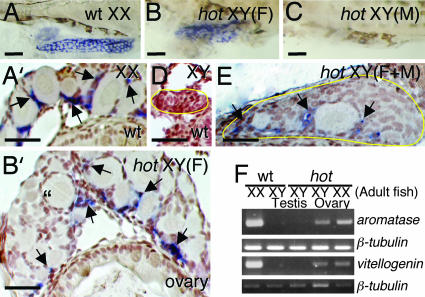Fig. 6.
Expression of aromatase transcripts in both wild-type and homozygous hot medaka. Wild-type (A and D) and hot-homozygous (B, C, and E) larvae at 20 dph were hybridized with an aromatase probe. Aromatase signals are detectable in the wild-type ovary (A) and in the ovarian-type gonads of the hot-homozygous mutant (B). (A′ and B′) Shown are sections of the gonads in A and B, respectively, demonstrating expression of aromatase in the somatic cells near the ocytes (arrows) in both wild type (A′) and hot homozygotes (B′). Aromatase signals are not detected in the gonads of XY hot homozygotes with testicular development (C) or XY wild-type (D). In XY hot-homozygous gonads possessing both ovarian and testicular components (E), aromatase signals are detected only in the region of somatic cells that surround the oocytes (arrows). (F) RT-PCR analysis of aromatase in the gonads and vitellogenin in the liver in adult fish (6 months old). Both vitellogenin and aromatase are expressed in the phenotypically female fish (i.e., wild-type XX, XX hot-homozygotes, and XY hot-homozygotes, showing the development of ovaries), but not in phenotypically male fish. [Scale bars, 0.5 mm (A–C); 0.1 mm (A′–C′, D, and E).]

